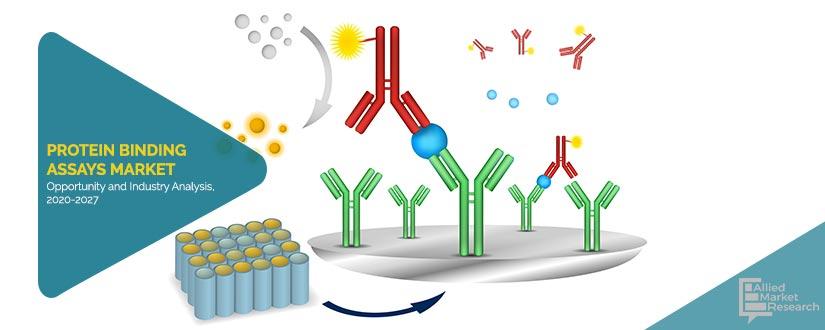The very huge bulk of molecular drugs are bound to blood plasma proteins by reversible methods immediately after the administration is done. Deciding and regulating the drug-protein binding extent is a very important factor when the drug development is taken into consideration as it impacts the efficacy of the compound along with the clearance rate, dosing, and drug interaction potentials. Rapid Equilibrium Dialysis (RED) is the most commonly used and efficient method that helps in the determination of the percentage of the plasma protein binding for a particular drug candidate.
Protein binding assay is important for the preclinical processes that are involved in drug development. Different biotechnological and pharmaceutical companies are running various initiatives which are helping address the ever-increasing demand for the therapies are their advancements.
The protein binding assay requires a 96-well dialysis unit HTD96b dialyzer. Sometimes the complete plasma protein or a single plasma protein like albumin is used in the protein binding assay. Plasma proteins are available widely in the nature in various species like humans, dogs, rats, and mice.
COVID-19 scenario analysis:
Pharmaceutical and biotech companies together with governments around the globe are working to address the COVID-19 outbreak, from supporting the development of vaccines to planning for medicines supply chain challenges. Currently, around 115 vaccine candidates and 155 molecules are in the R&D pipeline. Moreover, commonly used drugs such as Hydroxychloroquine have witnessed a dramatic surge in demand for the management of COVID-19. Such high demand for these drugs has presented huge opportunities for manufacturers of COVID-19 management drugs, as many developed countries are short of these drugs. Owing to the demand for vaccine and treatment drugs for COVID-19, the pharmaceutical and biotechnology industry is expected to witness a significant growth in the future.
Owing to such factors, COVID 19 is expected to have a significant impact on the Protein Binding Assays market.
Top impacting factors: Market Scenario Analysis, Trends, Drivers and Impact Analysis:
Various pharmaceutical and biopharmaceutical companies have been investing in the preclinical screening activities which are helping them in the late-stage failures and for the development of therapeutics segment.
The protein binding assays are highly expensive and require a huge capital investment, technological accomplishments, and human resources. Protein binding assays help in the development of drug discovery.
There has been a scarcity of new drugs and their demand for drug therapies has increased in recent times due to their focus on drug discovery. Many pharmaceutical and biotechnology companies are trying to progress and to serve the growing demand for novel drugs, which are leading to an increase in drug discovery activities. This is increasing the total number of drug candidates.
However, if the drug stops or fails in the later stages of the development or trials, the investment by the company has vanished. Therefore, preventive measures are taken up by the manufacturers during the later stages of drug development; therefore pharmaceutical companies are careful while investing and usually invest only in the earlier stages of the preclinical testing methods.
Existing technologies and their recurring issues are a major constraint for market growth for the protein binding assay market.
New product launches and acquisitions to flourish the market:
On March 5th, 2018, Thermo Fisher and Montreal Neurological Institute came into an agreement, which helped the institute in the generation of cell lines which used protein binding assays for the study neurodegenerative diseases.
On February 19th, 2019, Charles River was acquired by Citoxlab which helped them in strengthening their position in the field of drug discovery & development.
Surge in usage in Pharmaceutical & biotechnology companies applications:
Pharmaceutical & biotechnology companies are the most dominant and major end-users in the protein binding assay market. The companies hold a majority of the shares in global pharma production and have made significant-high investments on preclinical testing stages of drug discovery.
New Contract Research Organizations are been launched and are focusing on developing in the field of therapeutics. Additionally, CROs are increasing and the demand for these organizations is increasing due to the profits earned due to outsourcing the pharmaceutical manufacturing and quality control steps.
Key benefits of the report:
- This study presents the analytical depiction of the global Protein Binding Assays industry along with the current trends and future estimations to determine the imminent investment pockets.
- The report presents information related to key drivers, restraints, and opportunities along with detailed analysis of the global Protein Binding Assays market share.
- The current market is quantitatively analyzed to highlight the global Protein Binding Assays market growth scenario.
- Porter’s five forces analysis illustrates the potency of buyers & suppliers in the market.
- The report provides a detailed global Protein Binding Assays market analysis based on competitive intensity and how the competition will take shape in coming years.
Questions answered in the Protein Binding Assays Market research report:
- What are the leading market players active in the Protein Binding Assays market?
- What the current trends will influence the market in the next few years?
- What are the driving factors, restraints, and opportunities in the Protein Binding Assays market?
- What are the projections for the future that would help in taking further strategic steps?
Protein Binding Assays Market Report Highlights
| Aspects | Details |
| By Technology |
|
| By Products and Services |
|
| By End-user |
|
| By Region |
|
| Key Market Players | Charles River, GE Healthcare, Bioduro., Thermo Fisher Scientific, Inc., Eurofins Scientific, Evotec (Cyprotex), Sovicell GMBH, 3B Pharmaceuticals, Creative Biolabs, Absorption Systems LLC |
Loading Table Of Content...




